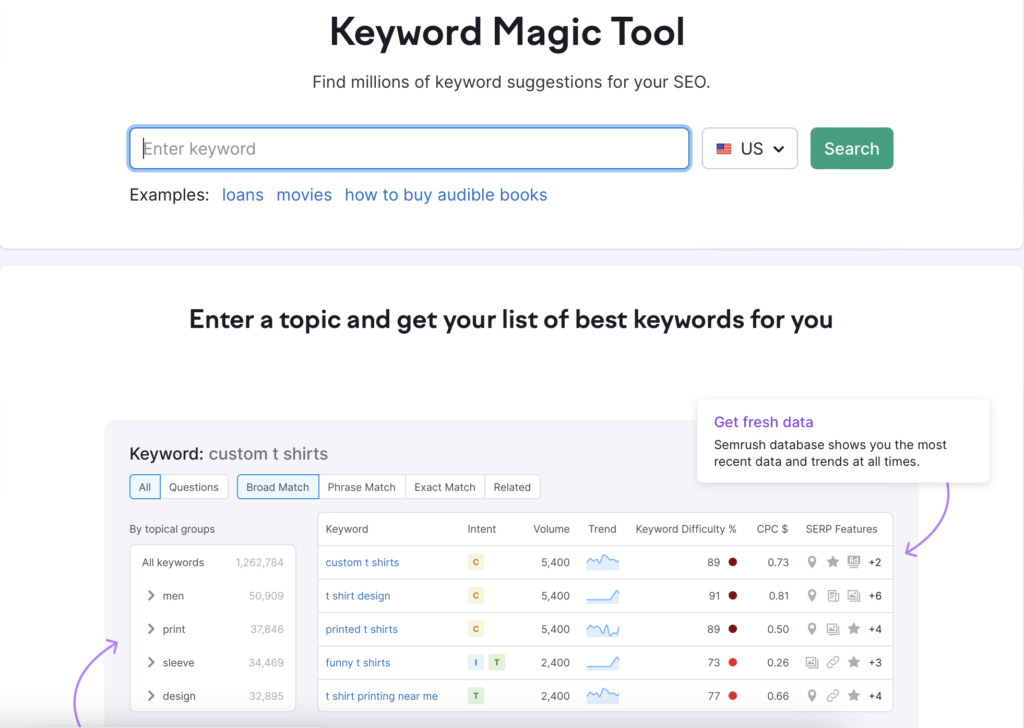AFFILIATE MARKETING
What It Is & How to Leverage it in 4 Easy Steps in 2024

When you create great content, you already know that it requires keyword research to get your customers to find you or make a purchase. If you know what they’re looking for when they search for pages like yours, you can cater to their needs. In other words, you need to know what their keyword intent is so that you can more accurately market.
What is keyword intent, and how can you leverage it for your SEO?
Let’s dive in!
What is Keyword Intent?

Before we can dive into leveraging this important concept for your SEO, it’s important to understand just what it is. Keyword intent (sometimes also referred to as search intent) is the understanding of what any given user wants to accomplish with their search query.
To identify keyword intent, you need to have a detailed understanding of your audience. Google aims to give its users exactly what they’re looking for, and it has grown in leaps and bounds when it comes to understanding search intent.
The result is a more seamless experience for the end user, but it can help you craft a well-designed website as well.
If you know what people want when they enter certain keywords, you can target all content marketing for that purpose. More people will have a positive experience on your website, get what they came for, and ultimately have the option to make a purchase when they’re ready.
How Keyword Intent Relates to Search Engine Optimization


Does knowing your keyword intent help you rank higher on Google and other search engines? The good news is that Google is very sophisticated and can pinpoint intent keywords quickly. If your website can deliver on the promise that you put out there, you may stand a chance of ranking higher in SERPs for a specific query.
For example, consider the customer who wants to “buy sneakers.” Google knows they want to make a purchase, so it shows them e-commerce websites. Someone who searches for “best sneakers for long-distance running” likely wants to learn more about various styles. Google instead shows informational articles and comparisons.
If you can nail the search intent with your content marketing, you have every chance of claiming that coveted top spot on the results pages.
Make sure to do your keyword research so that you know what your audience is searching for and can nail it on the first try.
How to Determine Search Intent


Determining search intent is as simple as paying attention to the words people put into the search box. Are they looking to buy, or are they looking for a review of a particular product or service? Is someone searching for general terms like “paintbrushes,” or do they want to know the “best paintbrushes for watercolor painters”?
This is your first and best indicator of the type of content people are looking for. As you do keyword research, pay attention to high-intent keywords (those that are likely to lead to a sale).
You can find search intent by using a tool like Keyword Magic (more on this in a minute) or simply by analyzing the top results on Google. Where are people spending their Google ads dollars? With an average cost per click of $2.69, nobody is throwing their money away on bad keywords.
This can be a good indicator that these particular keywords are likely to convert to sales, or people wouldn’t be spending money on them.
Types of Keyword Intent
Ready for more clarity on what people might be searching for when they enter a specific keyword? These five types of keyword intent will guide you to creating content that works for your unique and captive audience. There are five core reasons someone searches, so understand what they are here.
If you can master pinpointing search intent, you’re that much closer to a top spot on Google.
Commercial Intent


Maybe your ideal customer isn’t ready to buy from you — yet! They need a little more information on your products and services or a comparison of top brands in the industry. Oftentimes, you will see a customer search for reviews when they are in this commercial intent stage.
What does it mean for your business if you attract people with commercial intent? It means that they’re on the cusp of making a purchase, but they need to do a little more research. Help them along, and you might be able to score the sale.
Transactional Intent


If you were able to capture commercial intent and you did your job well, then you might be able to keep them when they transition to transactional intent. This is the stage where they are clearly ready to buy. The keyword intent moves from “reviews” or “best of” searches and starts to look a lot more like “buy.”
Informational Intent


Sometimes, people aren’t looking for a solution to their problems at all. They simply want more details on a topic that interests them. It’s all about the education process with informational intent. Could you hook them with a sale later on? Maybe, but you should focus on providing a high-quality experience in the here and now.
Give them detailed information about their desired topic, and you could score a reliable fan for life. Use this to teach someone how to do something or to answer their burning questions.


Maybe the user intent for a keyword is a little more straightforward: They want to get to a specific page somewhere on the internet. For example, let’s say that they want to pay their credit card bill, but locating the payment portal on the website is too hard. Instead, they might type in the name of their credit card company and “payment portal” to get Google to direct them there.
These are typically “low intent” keywords which means you’re unlikely to make a sale from them.
Local Intent


If you run a small brick-and-mortar local business, then you might want to leverage local intent. This is when people are specifically searching for a business in a geographic area close to them. It might be as simple as “Italian restaurants near me” or as detailed as “Carta bus stops in XYZ city.”
Understanding search intent is important here if you want to surface in the search results. These can be high-intent keywords because people are searching for businesses like yours locally. Convince them to come visit you by providing them with an excellent online experience.
How to Identify Search Intent
Whether you want informational keywords or commercial keywords, you might find that you need some support to identify search intent. Fortunately, you don’t have to figure it out all on your own. There are lots of methods you can use to start surfacing in the right search results, starting with Google.
Use Google to Your Advantage


If you’ve already done your keyword research, you know what keywords you want to rank for. Now, you need to know what the search engine is likely to show users. Google is one of the most powerful tools — and it’s free for you to start using it to your advantage. Take your keywords and plug them in to see what results come up.
Skim the data it provides you: snippets, featured images, People Also Ask, and even shopping results may all pop up. These search results lay the foundation for the type of content you should create to satisfy a searcher’s need. Even if they aren’t high-intent keywords, knowing what people expect from you can still be beneficial.
Based on what your competition is showing, you can decide how to target your content.
SEMRush & Keyword Magic Tool


If you don’t want to do the heavy lifting of searching search results, you may want to invest in a freemium tool like SEMRush. To get started and understand what informational keywords you may want to use, you can type them into the Keyword Overview tool.
Not only does it give you search intent, but it also allows you to check the competition with its SERP features. This gives you an idea of what other websites are doing to rank high on the search engines, giving you a clear path forward.
However, this isn’t the only tool that you can use to find keyword intent. SEMRush’s Keyword Magic Tool is a powerful option for finding keywords closely related to the seed keyword you were considering targeting. Type in your seed and watch as it spits out other targets along with their search intent.
Learn more in our Keyword Magic Tool review here!
How to Harness Search Intent for SEO
Once you know your intent keywords, it’s time to start leveraging them so that you show up on Google’s search engine results pages.
Here are a few ways to transform search intent into more sales and lead conversions for your brand.
Get to Know Your Audience and Niche


The first thing you should do when thinking of SEO is target a specific customer. Your audience is full of unique individuals, but they likely have some of the same pain points. If you want to show up in search results, you need to speak to those pain points and offer a solution.
Gain a deeper understanding of your audience and your niche so that you know what people are looking for when they stumble across sites like yours. To this end, you might create an ideal customer avatar or send out a survey to your best customers to find out the sort of things they are searching for on Google to brainstorm new topic ideas.
Perform Keyword Research to Find the Right Phrase


There are endless possibilities when it comes to what people will search for, no matter what their search intent might be. Don’t take a shot in the dark. Do your homework with keyword research. No substitutes for doing the heavy lifting will work. You need to have a clear idea of keyword search intent so that your content hits the mark.
You can use free tools like the Google Keyword Planner or SEMRush’s Keyword Magic Tool to clarify what people want to see from you.
Be sure to see our complete guide to keyword research and the best keyword research tools here.
Check the SERPs for Competition and Intent


Once you have narrowed down your keyword research, it’s time to see what the competition might be doing right here, right now. Your research on Google will certainly help at this stage of the game. Look at the content other sites are producing and ranking for.
Are they creating sponsored posts with Google ads or have featured snippets? Take a survey of the content, and it will give you a great idea of the commercial intent of a particular keyword.
If it doesn’t have high intent, then it may not be a keyword you want to target right now.
Knowing what the industry is doing around you will help you in the next step: creating the right content type.
Create the Right Content Type


Last but not least, your keyword intent dictates the type of content marketing you will do. You will need to center your content strategy around the search intent for your particular phrase. Whether you decide to make a video or a blog post, knowing what shows up best in the search results is key.
Target your relevant keywords and match the user search intent with your content.
Maybe it’s a sales page geared toward someone ready to buy, complete with FAQ pages to answer common objections. Maybe it’s a guide or a review for informational intent. You might even create a long-form blog post that details everything there is to know about your niche and product or service.
Final Thoughts: Getting to Keyword Search Intent
Is search intent important for helping you decide what to post and where to post it? This is one aspect of your SEO that you don’t want to leave to chance. Knowing a user’s intent makes it that much more likely that you will convert those users to paid customers when the time is right.
Whether you decide to use a tool like SEMRush or simply use Google, this guide will help you start to tease out high-intent keywords so that you can gain more readership and customers.
















